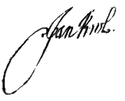Jan III Sobieski of Poland
| John III Sobieski | |
|---|---|

Portrait of John III, by Daniel Schultz
|
|
|
King of Poland Grand Duke of Lithuania |
|
| Reign | 19 May 1674 – 17 June 1696 |
| Coronation | 2 February 1676 |
| Predecessor | Michael |
| Successor | Augustus II the Strong |
| Born |
17 August 1629 Olesko, Poland |
| Died | 17 June 1696 (aged 66) Wilanów, Warsaw, Poland |
| Burial | Wawel, Kraków, Poland |
| Spouse | Marie Casimire Louise |
| Issue among others... |
James Louis Sobieski |
| House | House of Sobieski |
| Father | Jakub Sobieski |
| Mother | Zofia Teofillia Daniłowicz |
| Religion | Roman Catholicism |
| Signature |  |
John III Sobieski (Polish: Jan III Sobieski; Lithuanian: Jonas III Sobieskis; Latin: Ioannes III Sobiscius; 17 August 1629 – 17 June 1696), was King of Poland and Grand Duke of Lithuania from 1674 until his death, and one of the most notable monarchs of the Polish–Lithuanian Commonwealth.
Sobieski's military skill, demonstrated in wars against the Ottoman Empire, contributed to his prowess as King of Poland. Sobieski's 22-year reign marked a period of the Commonwealth's stabilization, much needed after the turmoil of the Deluge and the Khmelnytsky Uprising. Popular among his subjects, he was an able military commander, most famous for his victory over the Turks at the 1683 Battle of Vienna. After his victories over them, the Ottomans called him the "Lion of Lechistan"; and the Pope hailed him as the savior of Christendom.
John Sobieski was born on 17 August 1629, in Olesko, a small town near Lviv in Galicia, now Ukraine, then part of the Ruthenian Voivodeship in the Crown of the Kingdom of Poland, Polish–Lithuanian Commonwealth to a renowned noble family de Sobieszyn Sobieski of Janina coat of arms. His father, Jakub Sobieski, was the Voivode of Ruthenia and Castellan of Kraków; his mother, Zofia Teofillia Daniłowicz was a granddaughter of Hetman Stanisław Żółkiewski. John Sobieski spent his childhood in Żółkiew. After graduating from the Nowodworski College in Kraków in 1643, young John Sobieski then graduated from the philosophical faculty of the Jagiellonian University in 1646. After finishing his studies, together with his brother Marek Sobieski, John left for western Europe, where he spent more than two years travelling. They visited Leipzig, Antwerp, Paris, London, Leiden and The Hague. During that time, he met influential contemporary figures such as Louis II de Bourbon, Charles II of England and William II, Prince of Orange, and learned French, German and Italian, in addition to Latin.
...
Wikipedia
